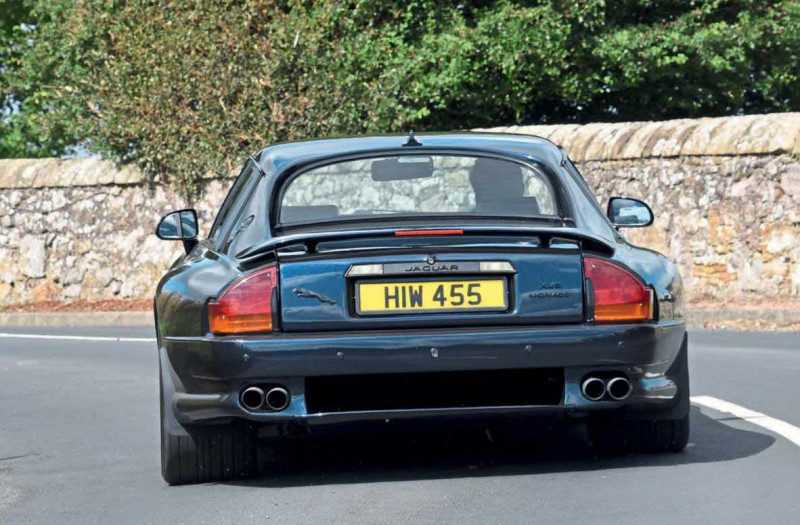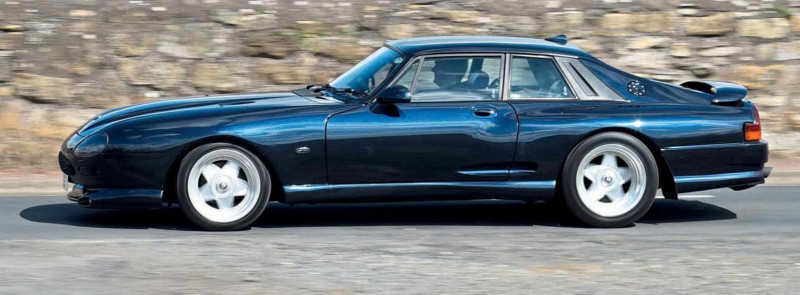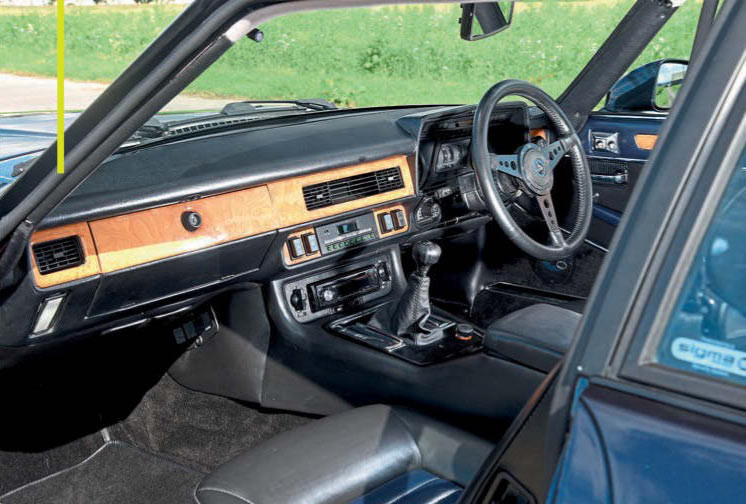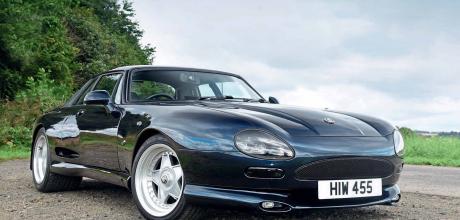1985 Jaguar XJ-S based PBB Monaco
The smoother lines and more modern appearance of the PBB Design Monaco are far from the XJ-S on which it was based. Only a handful were produced between the early Nineties and 2001 and we've tracked down what could be the final example. Words & Photography Paul Walton.
PBB DESIGN MONACO
We drive a rare example of the Jaguar XJ-S based-Monaco, one of only 12 that were converted between the early Nineties and 2001 by PBB Design, that features characterchanging glass-fibre body panels
Looks can be deceiving. Just ask anyone who has ever mistaken a fake Rolex for a real one or a petrol station-bought sandwich as actual food. Then, there’s this PBB Design Monaco. The soft lines, Perspex headlight covers and wide wheelarches might make it seem a reasonably new car – something from the Nineties or early 2000s, maybe – but it’s actually based on a 36-year-old XJ-S. Which was always the point behind Paul Bailey’s modifications to bring Jaguar’s Seventies-designed Grand Tourer more up-to-date.

Between 1992 and the early 2000s, his Bristol-based company, PBB Design, offered a series of modifications for the XJ-S under the name Monaco, completely changing the car’s look and character. Built in tiny numbers, it was one of the better-designed, modified examples of Jaguar’s big GT that were prevalent at the time.
Following a career in the aircraft industry, Bailey moved to Bristol-based Glenfrome Engineering, which produced lengthened five-door and open versions of the Range Rover, plus a futuristic design based on the SUV called the Facet. It also experimented with a long wheelbase version of the XJ-S. The company was dissolved in 1986. The following year, Bailey formed PBB Design and his first project was an aesthetically pleasing convertible version of the Lotus Esprit Series 3.
Painted in Loire Blue, Alistair’s Monaco is a fabulous-looking thing
While Paul had long admired the XJ-S in terms of its dynamics, its angular styling had never impressed him – so he penned his own version ensuring the changes would be possible. “There’s no point in dreaming up a design that couldn’t be built,” he said in the April 1992 issue of Jaguar Quarterly. “I wanted my car to be exactly as I drew it.” The concept remained just that, until the early Nineties when Paul’s brother, Stuart, prompted him into action.
His design included a longer, rounder nose that featured an downturned oval grille, and much wider wheelarches front and back to cover huge alloys. The glass-fibre panels simply attached to the car’s bodywork, requiring no structural changes, although Bailey had considered producing them in steel. He even involved Park Sheet Metal – which produced many of Jaguar’s own concepts, including the first XJ220 – during the early stages of the project. However, the metal around the arches had to be cut away, along with a little around the headlight area to make room for larger light pods where Bailey planned to use small projector lamps by Bosch. The bonnet was also new, again made from composite, and required a redesign of its hinge mounting due to the lower rake of the front.

The result was a handsome, modern car that still harked back to Jaguar’s past (as with the X100 XK8 from 1996 and even the 2013 F-TYPE). “There is probably more ‘spirit of the E-type’ in the PBB than in anything built yet,” was Jaguar Quarterly’s 1992 view.
It wasn’t a cheap conversion, though, since the bodykit alone cost £24,500 when fitted at PBB Design’s Bristol premises. This did include handsome 17in split rims from Compomotive, plus a suspension package developed by handling experts, Harvey Bailey Engineering. PBB Design was also able to offer various drivetrain upgrades, including a Rob Beere Engineering-developed 7.3-litre V12, and a totally bespoke interior that featured better-quality leather for the seats, a suede-covered dashboard and plush carpets.
Unsurprisingly, at this price only a handful were made. The general consensus is 12, mixed between coupes and convertibles, V12s and straight-sixes, but this can’t be confirmed. What also comes as no surprise to me is that the Sultan of Brunei was said to be a customer (as he had been at Glenfrome), purported to have bought the first two examples of the Monaco.
Sadly, Bailey wound up PBB Design in 2001 following a heart attack, and sold the moulds for the Monaco to a Texas-based engineering firm. Not long before the end, though, he made a complete set of Monaco glass-fibre panels for XJ-S owner Alistair Thomson, for a home conversion. Two decades later, the car is finally finished, meaning this could be the last PBB Design Monaco ever made.

“I’d owned my XJ-S [a 1985 3.6 coupe] since 1995, but, by the early 2000s, some of the panels needed replacing,” Alistair tells me. “To do so was going to cost more than the car was worth. Whenever I’d seen a Paul Bailey car I’d thought it looked stunning, so I decided that was the road to go down: strip the car and rebuild it as a Monaco.”
Rather than send the car to PBB Design, Alistair decided to do the work himself. Costing £4,500, his Monaco bodykit was manufactured to order a few months before Bailey pulled the plug on the company in 2001, which is why Alistair believes it to be the last one. He tells me that while he soon had the glass-fibre panels bonded onto the steel body, it was the finishing touches that took up most of the time, including a year in the bodyshop for the respray. Plus, although he’d paid PBB Design for the massive wheels, they were never delivered, and Alistair had to buy another set directly from Compomotive in the UK.
Alistair has added a few changes to further modernise the design, including fitting X350 XJ8 door handles and slimmer door mirrors from a Honda S2000 sports car, plus, since he disliked the original Bosch headlights offered by PBB, Alistair instead modified a pair of MG TF headlights and added LED lamps. He then fitted a simple, mesh radiator grille in black, rather than chrome as per the factory-made cars, and 3D-printed the badges for the rear.
Painted in Loire Blue, a modern Jaguar colour that changes shade depending on how the sun hits it, Alistair’s Monaco is a fabulous-looking thing. Long, low and very wide, it has perfect proportions despite the extended nose.
There’s plenty of speculation online as to whether the car might have influenced Jaguar when the company was designing the X100-generation XK8 in the early Nineties. Although that’s untrue (the car’s initial designer, Keith Helfet, has said many times in this magazine that he was influenced by Malcolm Sayer’s cars), due to the Perspex-covered lights, oval grille and rounder nose there’s a definite similarity between them. But, that probably comes from the general trend in the Eighties for automotive designers to move away from the harder, more angular lines that were popular in the decade before. However, due to the width of the arches and the new brake vent above the sill, the Monaco certainly has a little of the Lister Le Mans about it. But while those big arches feature soft, flowing and surprisingly elegant lines, and despite the size of the handsome five-spoke Compomotive alloys — a gargantuan, dumper truck-like 335/35/17 at the rear — the car lacks the Lister's innate aggressiveness.

When I open the door, the shape of the original steel skin is visible beneath the bonded-on glass-fibre. The interior is standard Eighties XJ-S, but, with its style and comfort, that's not a criticism. Alistair has considered covering the original veneer in carbon fibre, but doesn't think it would suit the car's original, or new, image.
Rebuilt by AJ Engineering, the 3.6-litre straight-six pulls strongly when I gun the throttle, sounding gruffer than normal due to the stainless steel sports exhaust that Alistair has also had fitted. The Getrag five-speed manual gearbox, there since new, allows me to control the revs through bends perfectly, offering surprisingly quick and accurate changes. Grip is greatly improved due to the huge contact patch of those massive tyres, and the big car sticks to the asphalt as if huge aero aids were pressing it down.
The PBB Design Monaco doesn't just split opinions, it decimates them, but my impression of this terrific-looking car is that it is much better designed than many of the other modified XJ-Ss of the time, including the Autostyle XJSS. Although similar in concept to the
Monaco, the proportions of Autostyle's XJSS are no match for Paul Bailey's version. Plus, it uses headlights sourced from a Vauxhall Corsa.
As for the man himself, Bailey had plans for resurrecting the design for the XJ-S' replacement. In October 2011, he wrote on the supercars.net forum, «Had ideas to do a wide-arched kit for XK, they must be cheap enough now and worthy of a 'new Monaco' treatment! If there is enough interest I'm happy to 'pen out' some ideas for Monaco II.» As far as I know, the idea never left the keyboard.
It might be easy to mistake the PBB Design Monaco as a more modern car, but it will never be confused for something plain and ordinary.
Thanks to: Alistair Thomson


